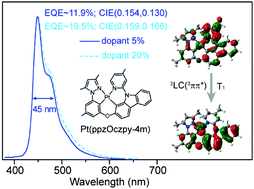High-color-purity and efficient solution-processable blue phosphorescent light-emitting diodes with Pt(ii) complexes featuring 3ππ* transitions†
Abstract
A series of tetradentate Pt(II) complexes featuring narrow emission spectra have been systematically exploited. The lowest excited states of the molecules can experience delocalized spin transitions during intersystem crossing, leading to local 3ππ* transitions with narrow emission spectra. We found that the photophysical properties expressed by decay lifetimes, radiative decay rates and full width at half maximum (FWHM) values in the spectra correspond to the configurational ratio of the local 3ππ* components, which could be regulated upon structure modification and environmental confinement. Photoluminescent data analysis with zero-field splitting of less than 14 cm−1 stresses the important role of the 3ππ* transitions. Pt(ppzOczpy-4m), simply modified by adding methyl to a Pt(ppzOczpy) frame, gives a 92% photoluminescent yield in dichloromethane and a narrow phosphorescent emission spectrum with a FWHM of 25 nm in the blue region. In application, solution processed deep-blue organic light-emitting devices based on Pt(ppzOczpy-4m) achieve a high maximum external quantum efficiency (EQEmax) of 19.5% with Commission Internationale de L’Eclairage (CIE) coordinates of (0.159, 0.166) and 11.9% EQEmax with optimal CIE coordinates of (0.154, 0.130).



 Please wait while we load your content...
Please wait while we load your content...